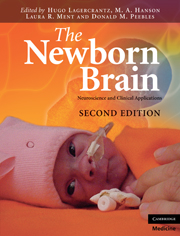Book contents
- Frontmatter
- Contents
- List of contributors
- Preface to the First Edition
- Preface to the Second Edition
- 1 Reflections on the origins of the human brain
- Section 1 Making of the brain
- Section 2 Sensory systems and behavior
- Section 3 Radiological and neurophysiological investigations
- Section 4 Clinical aspects
- 16 Infection, inflammation, and damage to fetal and perinatal brain
- 17 Hypoxic–ischemic encephalopathy
- 18 Clinical assessment and therapeutic interventions for hypoxic–ischemic encephalopathy in the full-term infant
- 19 Clinical aspects of brain injury in the preterm infant
- Section 5 Follow-up
- Section 6 Consciousness
- Index
- Plate section
- References
16 - Infection, inflammation, and damage to fetal and perinatal brain
from Section 4 - Clinical aspects
Published online by Cambridge University Press: 01 March 2011
- Frontmatter
- Contents
- List of contributors
- Preface to the First Edition
- Preface to the Second Edition
- 1 Reflections on the origins of the human brain
- Section 1 Making of the brain
- Section 2 Sensory systems and behavior
- Section 3 Radiological and neurophysiological investigations
- Section 4 Clinical aspects
- 16 Infection, inflammation, and damage to fetal and perinatal brain
- 17 Hypoxic–ischemic encephalopathy
- 18 Clinical assessment and therapeutic interventions for hypoxic–ischemic encephalopathy in the full-term infant
- 19 Clinical aspects of brain injury in the preterm infant
- Section 5 Follow-up
- Section 6 Consciousness
- Index
- Plate section
- References
Summary
Introduction
Perinatal brain injury is a common cause of cerebral palsy and other neurological disabilities that affect two per 1000 live-births (Stanley & Watson, 1985), an incidence that has remained static over the past 20 years (Pharoah et al., 1998; Colver et al., 2000). Although a longstanding opinion, first proposed by William Little in 1861, suggested that events during labor were entirely responsible for cerebral palsy, there is a growing body of epidemiological evidence arguing for significant involvement of infection and infection-associated neural inflammation in mediating damage to fetal and neonatal brain. Moreover, in discussing the role of infection, it is also important to differentiate between three different pathogenetic entities: first, injury due to direct infection as in meningitis or encephalitis; second, synergistic interactions between systemic, extraneural infection and hypoxic–ischemic insult, compounding the latter; and lastly, fetal or maternal infection that occurs outside the brain, but with effects on postnatal brain development.
Congenital infections and central nervous system toxicity
During gestation, many microorganisms can infect the fetus, causing severe birth defects as well as mental retardation. On the whole, pre- and perinatal infections account for 2%–3% of all congenital anomalies (Stegmann & Carey, 2002). Neurotropic infections can occur throughout pregnancy and during birth (França & Mugayar, 2004), but the peak incidence and occurrence of neuromorphological and developmental abnormalities depends on pathogen type.
Toxoplasma gondii
Following infection with the T. gondii parasite, maternofetal transmission increases steadily the later the maternal infection occurs during pregnancy.
- Type
- Chapter
- Information
- The Newborn BrainNeuroscience and Clinical Applications, pp. 245 - 260Publisher: Cambridge University PressPrint publication year: 2010



